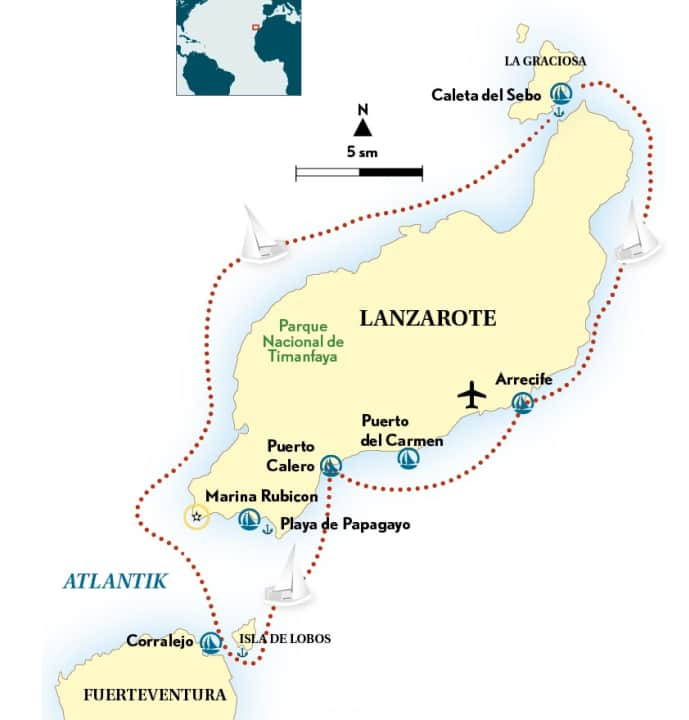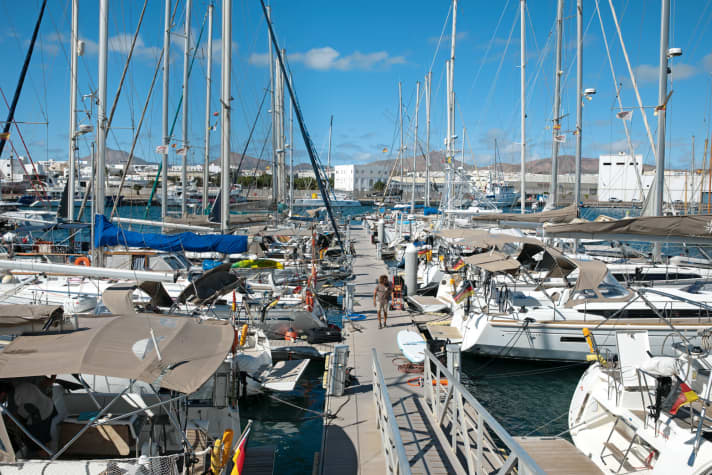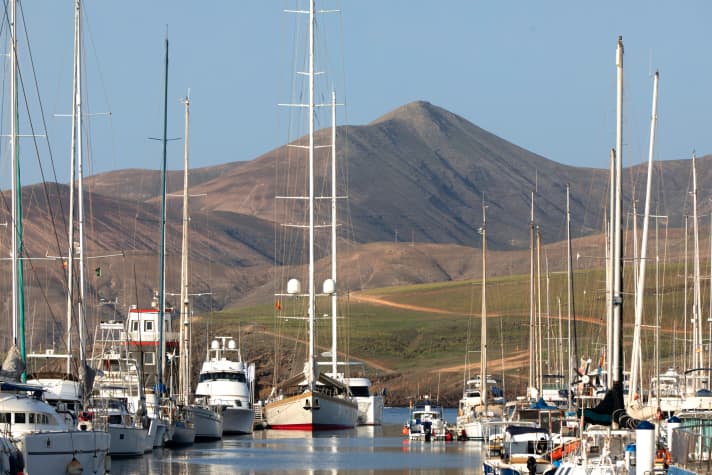Chartering on Lanzarote: Welcome to the world of fire, water and desert wind!






Lanzarote is an island in the Atlantic Ocean that is characterised by its extraordinary landscape of fire and water. The desert wind carries with it the smell of lava rock and salt water. The island offers a multitude of natural beauties to explore. There are volcanic mountains, black beaches and bizarre rock formations. The sea around Lanzarote is also unique: it is home to dolphins, turtles and various species of fish. Those interested in culture can learn about the history of the island in the picturesque villages or discover the artworks of artist César Manrique.
Attention when planning your trip to Lanzarote
It's hot, around 30 degrees. But most charter crews who set off on a cruise from Lanzarote at this time of year in early November will be more than happy to put up with this. When planning the route, however, the question will inevitably arise as to whether the classic "Lanzarote round trip" is the right one. This is because no matter which way round the island, you will have to cross against the trade winds for a day on either the west or east side. Depending on the wind strength, this means a lot of work on winches and sheets for the sailors. If the sea is still rough and the ship is leaning a lot, a robust stomach is also required.
This area gives you a taste of ocean sailing - it inspires you to dream of faraway lands"
Even on the recommended, much shorter eastern route from the charter base in Arrecife to La Graciosa, the lack of harbours and anchorages can easily add up to 40 nautical miles. This is certainly no problem for sporty sailors, but a family crew may have imagined their holiday differently. For them, we recommend sailing towards the south of the island instead of rounding it with a tailwind. There are several beautiful anchorages and harbours within striking distance of each other.
On course north, however, you are not only rewarded with a shore leave on La Graciosa. The crew also gets a taste of what ocean sailing is all about: the vastness and the movements in long swells inspire dreams of destinations much further away than the small volcanic island in the north of Lanzarote. "We could sail on to Casablanca," exclaims fellow sailor Timo, who wants to start a circumnavigation next year. "No, we can't," interjects Oli, "we're not allowed to leave a 25 nautical mile zone around the Canary Islands." Apparently, the charter company is also worried that its customers will suddenly be overcome by wanderlust.

Back in reality, a rock rises imposingly out of the sea in the haze ahead. Like La Graciosa, Roque del Este is part of the Chinijo archipelago. Like the cliffs in the north of Lanzarote, this is a nature reserve. Rare birds, turtles and marine mammals find refuge here. While the Roque del Este, Roque del Oeste and Montaña Clara are not allowed to be entered at all, La Graciosa is open to sailors. But only with advance booking. But then you can drop anchor in front of Playa Francesa. If you want to call at the harbour of Caleta del Sebo instead, you also need a binding berth reservation. Both the permit and the reservation must be requested from the Las Palmas harbour authority by email, preferably at least two weeks before the start of the trip. Fleet operator Lava Charter will take care of these formalities for you.
Caribbean feeling on La Graciosa
In the marina of Caleta del Sebo, a marinero assigns the boats to their berths and takes the lines. At the second attempt, we manage to moor with the stern to the jetty between two boats trimmed for long journeys. "Not bad for a charter crew!" we are greeted by their owners, who have each rushed to the railing with a fender in their hand.
To starboard is an Ovni 365 from Eckernförde, which seems to be equipped for all eventualities. The friendly sailing couple have no desire for publicity, but reveal that they want to sail to the Caribbean via the Cape Verde Islands and be back home in a year and a half. Oliver, who was born in Hamburg and now lives in Gran Canaria, is moored on the port side. He offers his Beneteau 50 for skippered charter. A real salt hump with sun-tanned skin, he has lived from sailing for 30 years.
On Oliver's recommendation, we later go to the "Enriqueta" restaurant, which is not on the waterfront, but off the beaten track in the third row. As it doesn't open until 8 p.m., the waiting time can easily be bridged with a walk through the town. Caleta del Sebo has an almost Caribbean atmosphere. Children bathe in the dark on the beach in front of the promenade, people sit everywhere in a relaxed mood. People are talking, singing and laughing. In front of a simple bar, three corpulent men are strumming their guitars like there's no tomorrow.
The atmosphere is so impressive that you want to preserve it. Even in the small supermarket, rhythmic music booms out of the speakers. We are the first ones in the "Enriqueta" on time, so it's almost embarrassing. 20 minutes later, however, all the seats are completely taken - but we've done everything right! The dishes on the table include prawns in hot oil with garlic, caramelised octopus, pimientos de padron and the fish of the day. Including drinks, the total for three people comes to 77 euros. Energised, we head back to the boat. Next door, a Frenchman sits on the bathing platform of his old ketch and smokes a cigarette - "Liberté toujours!".
Lanzarote has fantastic anchorages
The next day starts with the shortest leg of the trip: out of the marina and just under two nautical miles through El Rio to the only permitted anchorage on La Graciosa - Playa Francesa. As there are already a few yachts in the bay, we have to drop the anchor of the "Camino" in the outer area, where the water is not quite as turquoise as just off the beach. The tidal range here is three metres, the anchor goes to a depth of 14 metres with 40 metres of chain. As the ground can be rocky throughout the area, even under the sand, it is generally recommended to work with a trip line. This would make it possible to retrieve an anchor that may be jammed behind rocks.
After a short swimming session, we take the dinghy ashore, passing a hodgepodge of sailing yachts from all over the world. In addition to a few German and French flags, there are also national boats from the Scandinavian countries and even two from Australia. There's no question that the Canary Islands are a long-distance sailing hotspot.
At night, the top lights of the anchored yachts form a counterpoint to the sparkling "starry sky"
Shortly before reaching the beach, the outboard motor is raised and the dinghy is pulled onto the shore. Then it's time to climb Montaña Amarilla, the long-extinct volcano at the south-west tip of La Graciosa. The path winds its way up the last 50 metres to the crater rim. Sturdy footwear pays off, as the path is littered with sharp-edged volcanic debris on which it is easy to slip. Once at the top, the ascent is rewarded with a magnificent view: to the south, the view wanders to the turquoise-coloured anchorage off Playa Francesa and from there on to the 400-metre-high cliffs of the north coast of Lanzarote, above which the volcanic cone of Monte Corona towers.
Unfortunately, visibility is a little cloudy today, as the constant trade winds from the north-east have been joined by a calima. This is a local weather phenomenon on Lanzarote that builds up over the Sahara and drives huge amounts of desert dust as well as hot, dry air over the Canary Islands.
We are then drawn back to Caleta del Sebo. The lonely sandy tracks and the whitewashed houses give the village a Western atmosphere at lunchtime - you'd love to pull out your harmonica. Every now and then an off-road vehicle whizzes past, chauffeuring tourists to the island's beaches. In addition to Playa Francesa, the beach of Las Conchas in the north-west is very popular. Alexander von Humboldt is said to have landed there 300 years ago.
With the Passat in the south of Lanzarote
We take the dinghy back to the "Camino". The next day we have a long sail to Marina Rubicon in the very south of Lanzarote. This time we have the trade wind behind us and can relax and enjoy the 40 nautical miles. First thing in the morning, we call the marina, which is always full in autumn, to reserve a place. There is already a waiting list and we are told to try again in the afternoon. All right, we sail a south-westerly course with bullstander and autopilot.
Yellow-billed shearwaters plunge into the Atlantic, dolphin fins appear in the distance, a flying fish passes by on the starboard side. "If we stay on this course, we could be sipping a cocktail on Guadeloupe in three weeks' time," Timo says again. This time, Oli is also daydreaming, while the rugged west coast of Lanzarote passes by on the port side.
There is no harbour on this side of the island. Accordingly, there is little going on on the water. In the afternoon, we pass the lighthouse at Punta Pechiguera on the south-western tip of Lanzarote. Time to call the Marina Rubicon again. But it's full. So we change course - our new destination is the Isla de Lobos to the north of Fuerteventura. To do this, we have to cross the La Bocayna strait between Lanzarote and Fuerteventura, which is known for its jet stream. The wind actually picks up by ten knots. With a reef in the main, we speed towards an anchorage in the south of Lobos. It is permit-free. However, if you want to go to the island, you have to apply for a permit online in advance. A maximum of 400 people are allowed on the small island per day.
It's worth going ashore. There is a small jetty in the Caleta de la Rasca, a lagoon-like bay that is protected from the surf by volcanic reefs. As the spot is popular with snorkellers, it can only be approached by paddling. It is also important to keep an eye out for sharp-edged volcanic rock, but this is not a problem due to the incredibly clear water.
Nature is surprisingly diverse
Apart from a small restaurant, there is nothing to spend money on on Lobos. Swimming, snorkelling and hiking are the order of the day on the bird sanctuary island. The seven and a half kilometre circular route is surprisingly varied and can be described as barren lunar landscapes, sandy steppes and green lagoons. From the Faro de Martino at the northern tip of the island, which used to be fuelled with olive oil, you can enjoy a beautiful view of La Bocayna and the south coast of Lanzarote. If you have your swimming gear with you, you can relax in the sand of Playa de la Concha or on the rocky shore of Caleta de la Rasca.
Back on board the "Camino", Marina Rubicon turns us down again. So we head for Puerto Calero in the south-east of Lanzarote. Unfortunately, this means that the famous anchorage off Playa de Papagayo is no longer available, but we can't expect another night at anchor from one of our maladjusted fellow sailors. As we are now heading north again, we have to cross again.
We arrive in Puerto Calero in the wake of a yellow submarine and are met by a marinero at the reception jetty who escorts us to our berth. The harbour has a good infrastructure, including a supermarket and pharmacy. However, everything here is a little more expensive due to the proximity to the tourist centres.
On the last day, we return to Arrecife. Charter manager Jan picks up the boat at the petrol station. As a welcome-back present, there is a beer for everyone on the jetty. Equipped in this way, the cruise in the area of the volcanoes and the desert wind can be reviewed once again. However, the dusty Calima has long since disappeared again.
Tips for the cruise and shore leave
Marina Lanzarote, Arrecife
The island's capital offers a fully equipped harbour for yachts of all sizes. It is usually the first port of call for long-distance travellers coming from southern Europe. Lava Charter is also based here. Bars and restaurants can be found in the immediate vicinity of the harbour.

César Manrique Museum
A visit to the museum house in Haria, where the artist and architect Manrique lived and created, who is connected to the island like no other, is a must for every visitor to understand the spirit and nature of Lanzarote.

Jameos del Agua
An impressive art and cultural centre, also created by Manrique, which was integrated into a lava tube. Albino crabs can be observed in the underground lake, and there is also a concert hall and catering in a great atmosphere.

Marina Rubicon
Popular marina in the south with perfect infrastructure such as a variety of restaurants and a shopping centre. There is also a car hire station for island excursions and a diving centre that organises tours to the Museo Atlántico.

Timanfaya National Park
Impressive, albeit barren landscape characterised by volcanoes and the western cliffs. Guided hikes or dromedary tours are a highlight. Otherwise, buses take you along narrow paths through the volcanic fields.

Puerto Calero
Modern and well-protected marina in the south-east of the island, where, in addition to a colourful culinary offer and an exclusive shopping mile, a yellow submarine is stationed that offers dives to the fishing grounds in front of the harbour.

Things to know for the Lanzarote cruise
The precinct
The island can be easily circumnavigated and explored in a week with detours to La Graciosa and the Isla de Lobos. Apart from the long stages from Arrecife to La Graciosa and along the west coast, there are anchorages and marinas within easy reach. It is worth planning extra days for excursions ashore. The supply in the harbour towns is good, but somewhat limited on the offshore islands.
Navigation & Seamanship
The area does not pose any major navigational challenges. The harbours are all sufficiently deep and equipped with finger piers that adapt to the tides. The tidal range is between one and three metres. The bottom in the bays is often rocky. It is therefore advisable to use a trip line when anchoring. With its help, an anchor that may be jammed behind rocks can still be retrieved.
Wind & Weather
The most popular time to visit is winter, when temperatures are between 20 and 24 degrees. Thanks to the trade winds, Lanzarote then offers constant winds from the north-east. Along the east coast, the swell is more moderate, but between the airport and Costa Teguise it blows much stronger than on the west coast due to wind acceleration between the volcanoes. Between the northern tip and La Graciosa, as well as between the southern tip and Fuerteventura, the wind picks up by up to ten knots due to a jet effect. During a calima, the Canary Islands are hit by a veil of sand and hot, dry air from the Sahara.
Literature & Charts
Sailing guide "Atlantic Islands" (in English), approx. 50 euros, and nautical chart E2 "Islas Canarias", approx. 32 euros, both from Imray-Verlag.
Charter
We were travelling with a Dufour 412 GL from Lava Charter. It costs from 3,350 euros per week. The smallest boat in the fleet is a Bavaria Cruiser 37, the largest a Bavaria Cruiser 56. Information and booking: 07931/498 38 96
Anchorages
There are recommended anchorages on Lanzarote, La Graciosa and the Isla de Lobos. In the north, on the south side of La Graciosa at the foot of the Montaña Amarilla volcano, lies Playa Francesa in a bay that offers very good protection from northerly winds. On the south coast of Lanzarote there is a marvellous anchorage off Playa Papagayo. Here too, yachts find shelter from the prevailing trade winds from the north-east. There is another beautiful anchorage in the south of the Isla de Lobos, but it can get choppy when the current shifts.

